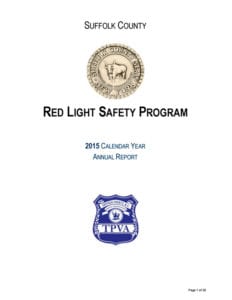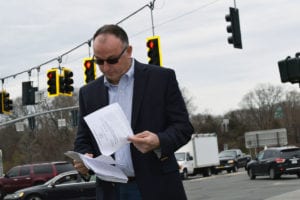
By Victoria Espinoza
The results are in for the 2015 Red Light Safety Program Annual Report — the most recent report to date — but there are still questions to be asked. The report, released in April, showed in 2015 a total of $31 million in gross revenue was collected from the program for citations issued from the start of the program in 2010 but paid in 2015 — a drop of some $1.9 million from the previous year.
However, an entire section is missing on accident data, which in years past indicated how many accidents occurred from right angles, rear ends, accidents that involved injury, what intersections they occurred at and more.
“It’s a disgrace,” Suffolk County Legislator Rob Trotta (R-Fort Salonga) said in a phone interview. “They say it’s coming — but they won’t even tell us who prepares the report.”
Trotta is not the only person to raise this concern.
Personal injury lawyer David Raimondo, based in Lake Grove, agreed not knowing what company prepares the report is a red flag. He has worked on several injury lawsuits having to do with red light camera intersections and has filed a Freedom of Information Law request to discover what company creates the current annual reports on the program. Just last month he called for a federal investigation into the program.

“We don’t know who makes the report, they [Suffolk County government] claim the data used is correct, but I’m challenging that right now because I don’t think their data is accurate,” he said.
The county executive’s office did not respond to requests for comment. Every annual report has the Suffolk County seal on the cover as well as the seal of the county’s office of Traffic and Parking Violations Agency. All services in maintaining, operating and managing the red light cameras are done by Xerox, a corporation that entered into a contract with Suffolk County. Xerox provides a monthly invoice to the county for contractual requirements, and according to the study was paid $9.4 million that year. But it’s still unclear which entity condenses the raw data and creates the annual reports.
Raimondo also took issue with an article from the Insurance Institute for Highway Safety referenced in the 2015 report. “Red light cameras installed at intersections reduced the number of fatalities due to crashes at these intersections … there was a steep increase in fatalities at intersections that removed red light cameras,” the report stated.
The article also included data from 57 cities throughout the country between 1992 and 2014, comparing trends in fatal crash rates in those cities with trends in 33 cities that never had cameras.
The lawyer called the article “propaganda,” and said he has worked with many scientists and engineer experts who confirm red light camera programs do not reduce fatalities.
Another problem with the Suffolk County study, Raimondo said, is it does not include data on accidents involving bicyclists or pedestrians.
“Every single intersection with a camera and a crosswalk needs a report,” he said.
Red light cameras are placed in two types of intersections: New York State intersections, where a state road meets a state, county or town road; and non-state intersections, where a county road meets a county or town road. According to the report, intersections are chosen based on where the cameras would yield the highest safety result, but Raimondo doesn’t buy that.
“They’re putting them in areas with the highest volume of people who don’t want to go to court and can afford to pay the ticket,” he said. “They’re targeting middle class people. It’s a real racketeering operation, it’s enterprise corruption.”“It’s an insult to the residents.” — Rob Trotta
Trotta echoed the sentiment.
“It’s a sham,” he said. “It’s the equivalent of a 63 percent tax increase on resident’s general fund tax, except this way the Suffolk County executive can say he didn’t raise it — but in actuality he did and it’s absurd. He [Steve Bellone (D)] thinks the people of Suffolk County are idiots. It’s an insult to the residents.”
According to the report released last month analyzing the 2015 data, 352,472 red light camera fines were paid in 2015, including payments immediately after first notice of a ticket and court-related fines. This has led to more than $17.6 million in gross fine revenues for the year ($19 million in 2014 on 380,809 fines paid). These fines and fees are deposited directly into a Suffolk County comptroller’s account, according to the report.
Some areas across Suffolk County saw more red light camera incidents recorded and tickets issued in 2015, but others stayed at a steady rate or saw a decrease.
The study details how many incidents a red light camera intersection tracks in a certain year, as well as how many tickets are issued from those incidents.
In 2015 in Huntington Station on Oakwood Road, a huge 73,217 red light camera incidents were noted, with 3,741 tickets issued, compared to 9,773 incidents noted and 602 tickets issued in 2014. Lake Grove had 86,343 incidents with 4,636 tickets issued in 2014, and the next year that number jumped to 106,145 incidents yet saw a drop in tickets to 4,435. In East Setauket on Route 347, more than 1,000 incidents were recorded than the prior year at 37,594, however 45 fewer tickets were issued at 1,838. On Miller Place Road, 117,016 incidents were recorded in 2014, with 7,055 tickets issued, and in 2015 there was a drop in incidents tracked at 113,915, with 6,088 tickets issued.






